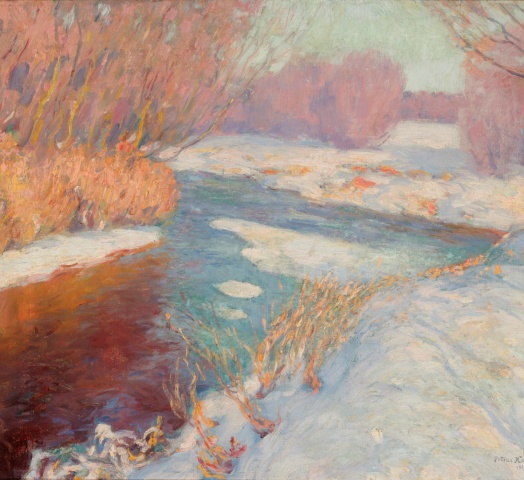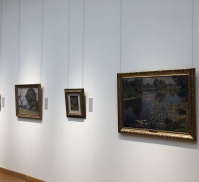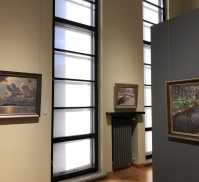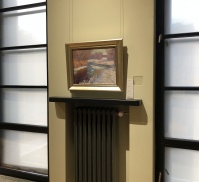Petras Kalpokas (1880–1945) and Environment
The exhibition “Petras Kalpokas (1880–1945) and Environment” at the M. K. Čiurlionis National Museum of Art.
Petras Kalpokas (1880–1945) – one of the most outstanding and productive Lithuanian painters, scenography artists and fresco authors of the first half of the 20th century was acknowledged not only in Lithuania, his creation was well known in Germany and Latvia. Professor P. Kalpokas taught and headed the painting studio at Kaunas Art School.
In the years of the First World War P. Kalpokas lost all of his works – 120 paintings during their transportation from his personal exhibition in Mitau (Latvia) to Berlin. In 1937, Vytautas the Great Culture Museum succeeded to purchase 16 of them from a private German collector H. Lüder-Lühr. This exhibition for the first time presents the whole oeuvre of P. Kalpokas, besides, it is supplemented by a great number of lost paintings which have been returned to Lithuania by private persons, mostly by the owners in other countries. Visitors are provided with the exceptional opportunity to acquaint with the most significant early period of P. Kalpokas’ creation, the paintings that brought him fame abroad, and cognize extraordinary talents of the painter in his youth.
On display – the most famous works by P. Kalpokas of different creative periods and genres of painting: Lithuanian, Italian and Swiss landscapes, improvised portraits of the closest to him people – his wife Olga Dubeneckienė-Kalpokienė, her sister T. Švedaitė, artist Ignas Šlapelis, ballet artist Marija Juozapaitytė, a portrait of his mother, several self-portraits that capture the most important phases in the artist’s life, as well as historical portraits of Lithuanian dukes, symbolic compositions, and pictures featuring the life of fishermen. Only several still-lives in the exhibition testify that the painter attached little importance to objects of civilization and nature morte. P. Kalpokas never painted views of buildings and cities. As an artist of sensitive, lyrical and delicate nature, P. Kalpokas had liking mainly for landscapes and adored nature. His manner of painting altered depending on the environment that surrounded him and provided with new creative impulses. Back in Lithuania, he drew together with his native and beloved nature for which he was longing abroad. However, here the artist lost the feeling for modernity that fueled his creative spirit in Munich.
P. Kalpokas was born in 1880 in the Miškinė farmstead, Rokiškis county, he died in 1945 in Kaunas. The artist actively participated at all first exhibitions of Lithuanian art, his artistic skills were noticed by Latvian artists Jānis Walteris and Vilhemas Purvītis. The spiritual environment in Munich matured P. Kalpokas’ painterly talent, enabled him acquire a distinctive and modern artistic expression. Here he received recognition, became a member of Secession, and displayed his works at Kunstverein exhibitions. He ranked high in Riga as an active participantat exhibitions of the Baltic Artists’ Union (1905, 1910, 1911, 1913, 1918).
The exhibition contains two works from the collection of the Lithuanian Art Centre "Tartle": Rivulet in Winter (1911) and Rivulet (1932).
The works of art on loan from: the Lithuanian National Museum of Art, Latvian National Museum of Art, the National Museum of Lithuania, Vytautas the Great War Museum, Kaunas City Museum, Museum of the Kaunas Archdiocese, Šiauliai “Aušros” Museum, Auction ARS VIA, Vytautas the Great Church (Church of the Assumption) in Kaunas, the Lithuanian Archives of Literature and Art, Dr Jaunius Gumbis, Arijus Ivaškevičius, Andrius Jankauskas, other private collectors.
Curator of the exhibition Dr Nijolė Tumėnienė
Architect Saulius Valius
Graphic design Naglis Rytis Baltušnikas
Coordinator Genovaitė Vertelkaitė-Bartulienė
The project has been partly supported by the Lithuanian Council for Culture

The exhibition “Petras Kalpokas (1880–1945) and Environment” at the M. K. Čiurlionis National Museum of Art.
Petras Kalpokas (1880–1945) – one of the most outstanding and productive Lithuanian painters, scenography artists and fresco authors of the first half of the 20th century was acknowledged not only in Lithuania, his creation was well known in Germany and Latvia. Professor P. Kalpokas taught and headed the painting studio at Kaunas Art School.
In the years of the First World War P. Kalpokas lost all of his works – 120 paintings during their transportation from his personal exhibition in Mitau (Latvia) to Berlin. In 1937, Vytautas the Great Culture Museum succeeded to purchase 16 of them from a private German collector H. Lüder-Lühr. This exhibition for the first time presents the whole oeuvre of P. Kalpokas, besides, it is supplemented by a great number of lost paintings which have been returned to Lithuania by private persons, mostly by the owners in other countries. Visitors are provided with the exceptional opportunity to acquaint with the most significant early period of P. Kalpokas’ creation, the paintings that brought him fame abroad, and cognize extraordinary talents of the painter in his youth.
On display – the most famous works by P. Kalpokas of different creative periods and genres of painting: Lithuanian, Italian and Swiss landscapes, improvised portraits of the closest to him people – his wife Olga Dubeneckienė-Kalpokienė, her sister T. Švedaitė, artist Ignas Šlapelis, ballet artist Marija Juozapaitytė, a portrait of his mother, several self-portraits that capture the most important phases in the artist’s life, as well as historical portraits of Lithuanian dukes, symbolic compositions, and pictures featuring the life of fishermen. Only several still-lives in the exhibition testify that the painter attached little importance to objects of civilization and nature morte. P. Kalpokas never painted views of buildings and cities. As an artist of sensitive, lyrical and delicate nature, P. Kalpokas had liking mainly for landscapes and adored nature. His manner of painting altered depending on the environment that surrounded him and provided with new creative impulses. Back in Lithuania, he drew together with his native and beloved nature for which he was longing abroad. However, here the artist lost the feeling for modernity that fueled his creative spirit in Munich.
P. Kalpokas was born in 1880 in the Miškinė farmstead, Rokiškis county, he died in 1945 in Kaunas. The artist actively participated at all first exhibitions of Lithuanian art, his artistic skills were noticed by Latvian artists Jānis Walteris and Vilhemas Purvītis. The spiritual environment in Munich matured P. Kalpokas’ painterly talent, enabled him acquire a distinctive and modern artistic expression. Here he received recognition, became a member of Secession, and displayed his works at Kunstverein exhibitions. He ranked high in Riga as an active participantat exhibitions of the Baltic Artists’ Union (1905, 1910, 1911, 1913, 1918).
The exhibition contains two works from the collection of the Lithuanian Art Centre "Tartle": Rivulet in Winter (1911) and Rivulet (1932).
The works of art on loan from: the Lithuanian National Museum of Art, Latvian National Museum of Art, the National Museum of Lithuania, Vytautas the Great War Museum, Kaunas City Museum, Museum of the Kaunas Archdiocese, Šiauliai “Aušros” Museum, Auction ARS VIA, Vytautas the Great Church (Church of the Assumption) in Kaunas, the Lithuanian Archives of Literature and Art, Dr Jaunius Gumbis, Arijus Ivaškevičius, Andrius Jankauskas, other private collectors.
Curator of the exhibition Dr Nijolė Tumėnienė
Architect Saulius Valius
Graphic design Naglis Rytis Baltušnikas
Coordinator Genovaitė Vertelkaitė-Bartulienė
The project has been partly supported by the Lithuanian Council for Culture









